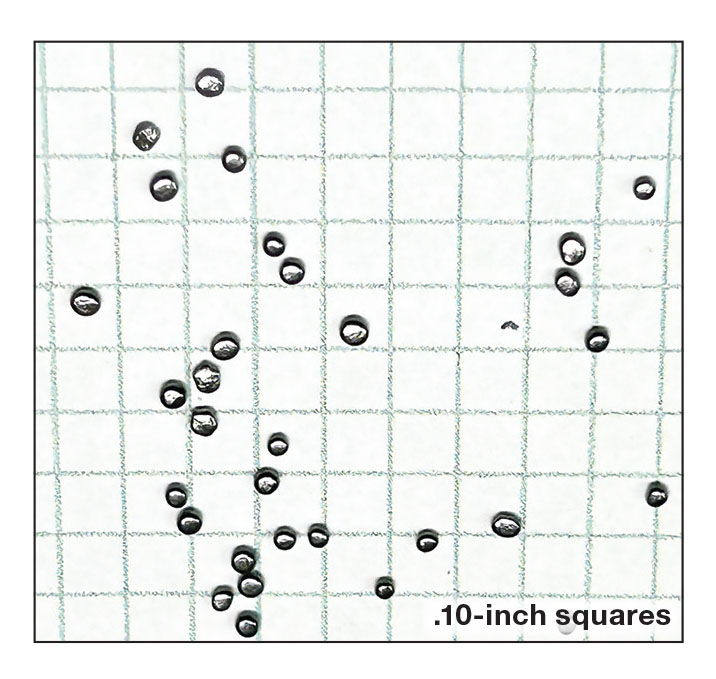Propellant Profiles
Hodgdon US 869
column By: Rob Behr | December, 24

Manufactured by St. Marks Powder in Florida, and marketed under the Original Equipment Manufacturer (OEM) designation WC 869, this powder is primarily used in the manufacture of military use 50 BMG and 25mm cartridges. When Hodgdon released it to the public as US 869 in 2006, it was intended to meet the growing civilian interest in 50 BMG rifles and other very large capacity cases like the 338 Lapua Magnum. On the burn rate charts, it sits between Hodgdon 50 BMG and Vihtavuori 20N29 right at the bottom of the list.
The individual grains of this double-base propellant were extremely uniform, especially in comparison to some of the European-manufactured propellants, and finely grained. The best measurements I could get were .0395 to .0425 inch across the length of the grain and a consistent .021 on the flats. With a bulk density of .98 g/cc, US 869 meters exceptionally well and resists bridging on case mouths, which is a real advantage when making large powder drops.
Hodgdon’s website lists loading data for 23 cartridges using US 869. Unsurprisingly, most of these cartridge names end in Magnum or at least should. There is one exception in this group, and it was the first one I tested, the much-loved 243 Winchester.

Speaking of compressed loads, all of the combinations I tested using US 869 were heavily compressed. That is just the nature of the beast when it comes to very slow rifle powders being used in cartridges typical of the civilian consumer market. I know shooters who shy away from compressed loads. If you are one of these handloaders, this is definitely not the powder for you.
On paper, I thought the best ballistic match for this powder might be in the 7mm Shooting Times Westerner. Based on a full-length 375 H&H cartridge necked down to 7mm, the cartridge is true overbore with about 93 grains of water capacity. With the now to be expected full to the gills charge of 90 grains of US 869 behind a Nosler 160-grain AccuBond, I was hoping to beat 3,000 fps. It did come close, averaging 2,958 fps with an extreme spread of 41.1 fps. Overall, this did seem to be a workable combination in my rechambered Remington 700 Alaskan, but it did give up a noticeable amount of velocity in comparison to my current load using Ramshot Magnum.
The two 6.5-caliber rifles I shot using US 869 produced an unexpected result. The first was the aforementioned 6.5 PRC loaded with 68.5 grains of powder and a Hornady 140-grain SST bullet. This combination resulted in an average velocity of 2,757 fps and an extreme spread of 42.4 fps from my wife’s 24-inch barreled Mossberg Patriot Predator. Trust me on this, that rifle is at its speed limit with this powder. There is no more room in the case. The second 6.5-caliber rifle out on the range that morning was my Cooper Arms Model 22 in 6.5-284 Winchester. That rifle and its 26-inch barrel using 65 grains of US 869 produced an average of 2,829 fps with an extreme spread of 38.5 fps using more of the Hornady 140-grain SST bullets. This is the classic ballistics battle, a longer barrel versus more propellant. In this instance, the extra 2 inches of barrel really paid off.
Of the six cartridges I tested, it was the 338 Lapua Magnum that seemed best suited to US 869. I’d found a Savage Long Range Hunter on consignment at our local gun shop and snuck it into my gun safe while my wife was away on business. It languished there for almost a year until I shot it for the first time during this testing. At about 11 pounds including the optic, the Savage is not a terribly heavy rifle, considering its velocity and energy. What it does have is a spectacularly effective muzzle brake that benefitted from the very large charge masses provided by US 869. After being attacked by my 7mm STW all morning, shooting the Savage was a pleasant surprise. As an added bonus, the silly thing shot less than one inch.
The only tough thing about loading the Lapua was watching the level of my powder measure drop every time I threw a charge. At 64 rounds to the pound, that rifle is going to hurt my wallet.
.jpg)


